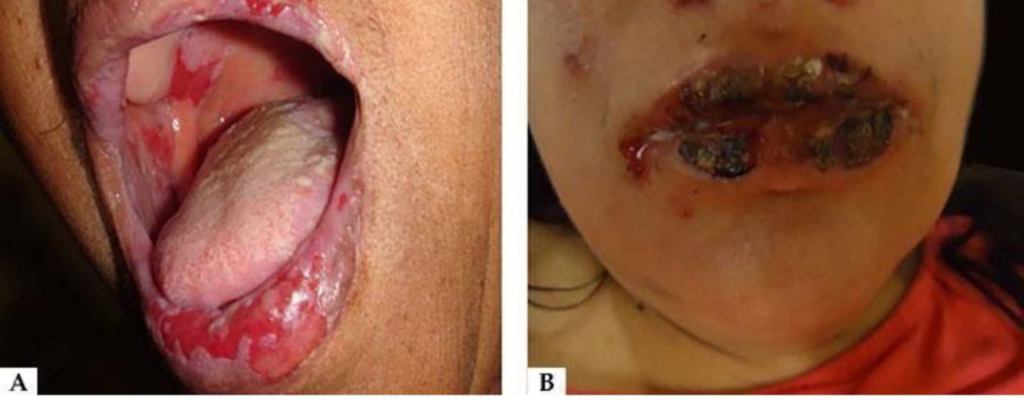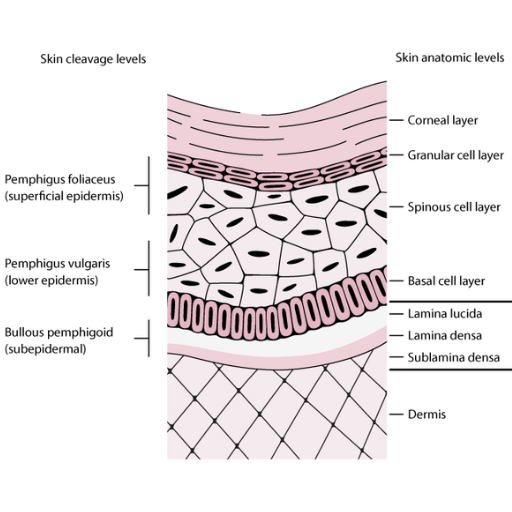Blog
Pemphigus Vulgaris: Hope Beyond Blisters

Pemphigus vulgaris is a rare autoimmune disease that causes blistering of the skin and mucous membranes. It’s important to remember that I am a large language model and cannot provide medical advice. If you have any concerns about your health, please consult with a healthcare professional.
Causes of Pemphigus vulgaris:
Pemphigus vulgaris, while not entirely understood, has several contributing factors believed to play a role in its development:

Autoimmune Dysfunction: The primary culprit is an autoimmune response, where the body’s immune system mistakenly attacks its own proteins, specifically desmoglein, a crucial component holding skin cells together. This attack leads to the formation of blisters.
Genetic Predisposition: Research suggests certain genetic variations can increase susceptibility to pemphigus vulgaris. While not directly causing the disease, these variations may influence the immune system’s response, triggering the autoimmune attack.
Environmental Triggers: Certain environmental factors might act as triggers in individuals with underlying genetic susceptibility. These triggers could include:
- Medications: Certain medications, like penicillamine and sulfasalazine, are known to trigger or worsen pemphigus vulgaris in some individuals.
- Infections: Infections, particularly viral infections like HIV, might trigger pemphigus vulgaris in susceptible individuals.
- Ultraviolet Radiation: Excessive exposure to sunlight can exacerbate pemphigus vulgaris symptoms.
Stress: While not a direct cause, stressful events may worsen pemphigus vulgaris symptoms or trigger flare-ups.

It’s important to remember that research on the exact causes of pemphigus vulgaris is ongoing, and the specific factors involved in each individual case can vary. If you have any concerns about your health or potential risk factors for pemphigus vulgaris, it’s crucial to consult with a healthcare professional for proper diagnosis and guidance.
Diagnosis of Pemphigus vulgaris:
Diagnoses involves a multi-faceted approach, aiming for a clear and accurate picture. Here’s what you can expect:

Medical History and Physical Examination:
- Your doctor will discuss your medical history, including any medications you’re taking, family history of autoimmune diseases, and potential triggers for pemphigus vulgaris.
- A thorough physical examination will be conducted, focusing on the location, size, and appearance of the blisters, especially on mucous membranes like the mouth or genitals.
Diagnostic Tests:
- Skin Biopsy: A small sample of skin from a blister or surrounding area can be examined under a microscope to identify characteristic signs of pemphigus vulgaris.
- Blood Tests: Specific blood tests can detect antibodies targeting desmoglein, the proteins holding skin cells together.
- Immunofluorescence Tests: These tests use fluorescent dyes to directly visualize antibody deposits on skin or mucous membrane samples.
Additional Imaging:
- In some cases, imaging tests like CT scans or X-rays might be used to assess internal involvement or potential complications.
Collaboration and Expert Consultations:
- Depending on the complexity of the case, your doctor may collaborate with dermatologists specializing in autoimmune diseases or other healthcare professionals for a comprehensive diagnosis.
Remember:
- Diagnosis isn’t always straightforward, and additional tests might be needed for confirmation.
- Open communication with your doctor about your symptoms and concerns is crucial throughout the process.
- Early diagnosis and prompt treatment are essential for managing pemphigus vulgaris effectively.
Types of Pemphigus vulgaris:
Pemphigus vulgaris, while the most common type, is just one branch of a broader family of autoimmune blistering diseases called pemphigus. Let’s explore the different types and their unique characteristics:

1. Pemphigus Vulgaris:
- The most frequent form, characterized by large, fragile blisters on the skin and mucous membranes, especially the face, scalp, trunk, and limbs.
2. Pemphigus Foliaceus:
- Blisters form in shallow layers of the skin, resembling thin, papery flakes that detach easily. The face, scalp, and seborrheic areas (chest, back) are frequently affected.
3. Pemphigus Vegetans:
- Thick, wart-like lesions develop due to overgrowth of the skin at the blister sites. Often found in flexural areas like armpits, groins, and behind the knees.
4. Pemphigus Erythematosus:
- Initially presents as red, scaly patches resembling seborrheic dermatitis or lupus. Blisters may appear later, typically on the face, chest, and back.
5. IgA Pemphigus:
- This subtype targets a different protein than other pemphigus types. Blisters tend to be smaller and more superficial, often affecting children and young adults.
Remember:
- Each type presents with specific features, but overlap in symptoms can occur.
- Accurate diagnosis involves a healthcare professional’s assessment and tests.
- Treatments are generally similar across types, focusing on controlling the immune response.
Pemphigus Vulgaris Symptoms: A Blistering Reminder of Autoimmunity
Pemphigus vulgaris, an autoimmune disease, can be quite the unwelcome guest. It leaves its mark on the skin and mucous membranes in the form of blisters, making its presence known in various ways. Here’s a closer look at the symptoms:

Blistering Bonanza:
- The star of the show is the blister. These fragile bubbles can erupt anywhere, but they favor the face, scalp, trunk, and limbs. They can be large or small, single or clustered, and often leave painful erosions after bursting.
- Mucous membranes like the inside of the mouth, eyes, and genitals are also susceptible, causing discomfort and potential infections.
Beyond Blisters:
- Itching, burning, and stinging sensations can accompany the blisters, adding to the discomfort.
- Fever and fatigue are sometimes seen, indicating the body’s fight against the autoimmune process.
- Secondary infections can occur if the skin’s barrier is compromised due to the blisters.
Variations on a Theme:
- Pemphigus vulgaris can present with different subtypes, each with slight variations in symptoms:
- Foliaceus: Blisters form on superficial layers of the skin, resembling thin layers of tissue paper.
- Vegetans: Blisters cluster and thicken, forming wart-like lesions.
- Bullous: Large, fluid-filled blisters are the hallmark of this subtype.
Remember:
- These are just general symptoms, and the specific presentation can vary greatly from person to person.
- Early diagnosis is crucial for proper management and preventing complications.
- If you experience any of these symptoms, especially persistent or worsening blisters, consult a healthcare professional immediately.
Taming the Blister Storm: Treatment Options for Pemphigus Vulgaris
Pemphigus vulgaris, with its persistent blistery attacks, can be frustrating and debilitating. Thankfully, there are treatment options to help calm the storm and control the disease. Here’s a breakdown of the main approaches:

1. Corticosteroids:
- These are the workhorses of pemphigus vulgaris therapy. Topical steroids are used for milder cases, while oral prednisone is the first-line systemic treatment for moderate to severe cases.
- Corticosteroids suppress the immune system, reducing blister formation and promoting healing.
- However, long-term use comes with side effects like weight gain, osteoporosis, and diabetes.
2. Immunosuppressants:
- These medications work alongside corticosteroids to further dampen the immune response. Common choices include azathioprine, mycophenolate mofetil, and cyclophosphamide.
- They help reduce corticosteroid dosage and side effects, but carry their own risks, including increased vulnerability to infections.
3. Plasmapheresis and Intravenous Immunoglobulin:
- These therapies focus on removing circulating antibodies attacking the skin cells.
- Plasmapheresis replaces plasma containing the harmful antibodies with fresh donor plasma.
- Intravenous immunoglobulin provides healthy antibodies to replace the harmful ones.
- They are typically used for resistant cases or in combination with other medications.
4. Other Therapies:
- Dapsone, an antibacterial and anti-inflammatory medication, can be used as a steroid-sparing agent.
- Rituximab, a targeted therapy, depletes B cells producing harmful antibodies.
- Intravenous corticosteroids and plasma exchange are options for rapid control in severe cases.
5. Supportive Care:
- Gentle wound care, pain management, and emotional support are crucial for coping with the physical and emotional impact of the disease.
- Good nutrition and sun protection are important for overall health and preventing blister flares.
Remember:
- Treatment is individualized based on disease severity, patient health, and response to therapy.
- Close monitoring by a dermatologist and other healthcare professionals is essential.
- There is no cure for pemphigus vulgaris, but treatment aims to control symptoms, prevent complications, and improve quality of life.
Always prioritize consulting with a healthcare professional for proper diagnosis and treatment of pemphigus vulgaris.
https://blog.derma.pk/
Final Thoughts:
Pemphigus vulgaris, an autoimmune assault on skin proteins, manifests as relentless blistering. Early diagnosis and personalized treatment using immunosuppressants and corticosteroids, while unable to cure, can effectively manage symptoms, prevent complications, and improve quality of life. Always rely on healthcare professionals for guidance and remember, support networks and resources are key to navigating this challenging journey.
Derma and Dental clinic:
Derma & Dental Clinic stands out with its team of experienced doctors backed by scientific evidence in their chosen fields. Their diverse range of medical-grade procedures offer tailored solutions for various skin and dental needs. You can confidently book your consultation online or by phone and embark on your journey towards healthier skin and a radiant smile.
Location: Bahria Town, Lahore
Specialties: Dermatology and Dental Care
Website: Derma.pk
For Consultation:
- Online at Dermatology.pk
- WhatsApp: +923205999650
- Phone: 03041115000
Categories
- Accessoreis
- Acne
- Aesthetic Procedures
- Anti Aging
- Author
- Baby Care
- Beauty
- Beauty & Cosmetics
- Blog
- Body Care
- cosmetic procedures
- Dandruff
- Dental Bonding
- Dental Care
- Dental Fillings
- Dental Health
- Dermatologist
- Dermatology
- Doctor
- Downloads
- Eye Care
- Food
- Food and Nutrition
- Hair Care
- Hair Loss Treatment
- Haircare
- Hand and foot care
- Health
- Health and Wellness
- Healthcare
- Imported Products
- Kids and baby care
- Laser Hair Removal
- Lip Care
- Medication
- Men's skin care
- Men's Skincare
- Nail Care
- Nutrition
- Oily Skin
- Online Consultation
- Oral Health
- Personal Care
- Pharmaceuticals
- Procedures
- Products and Ingredients
- scalp care
- Science
- Self care and wellness
- Shampoo
- Skin and Scalp Conditions
- Skin Care
- Skin Care and lifestyle
- Skin care myths and facts
- Skin Treatment
- Skincare
- skincare products
- Smile Design
- sunblocks
- Teeth Whitening
- wellness
- Whitening and brightening














